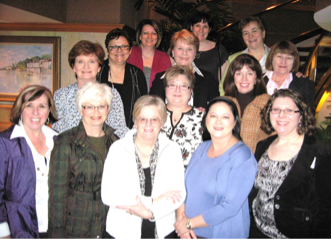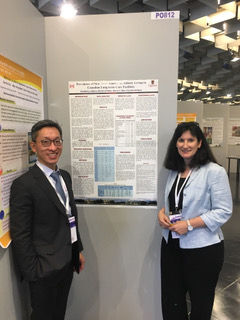
International Skin Tear Advisory Panel
Our History
ISTAP was founded in 2011 by Co-chairs: Dr. Kimberly LeBlanc (Canada) and Sharon Baranoski (USA), and Panel members: Dr. Karen Campbell (Canada), Dr. Kerlyn Carville (Australia), Dawn Christensen (Canada), Karen Edwards (USA), Mary Gloeckner (USA), Samantha Holloway (UK), Dr. Diane Langemo (USA), Alicia Madore (USA), Mary Ann Sammon (USA), Ann Williams (USA), and Dr. Mary Regan (USA)

ISTAP Past Presidents
Sharon Baranoski
2015-2016
Kimberly LeBlanc
2016-2018
Karen Campbell
2018-2020
Dimitri Beeckman
2020-2022
Samantha Holloway
Immediate Past President
2022-2024
-
Is it evident that cleansing involves irrigation rather than scrubbing?Indeed, we recommend employing gentle cleansing techniques and refraining from scrubbing, as it can potentially exacerbate any existing trauma.
-
Could you provide additional examples of skin tears occurring in pediatric populations? What are the typical appearances of such tears in children?Pediatric populations indeed present unique challenges in preventing and managing skin tears. In children, skin tears often result from trauma during dressing or device removal, or even from handling the child, particularly in neonates with delicate skin. While the appearance of these tears may resemble those in adults, the mechanisms of injury differ significantly.
-
Is Allevyn Gentle Border suitable for securing purposes?The suitability of using bordered foam dressings like Allevyn Gentle Border depends on the condition of the peri-wound and surrounding skin. While they can be utilized, it's crucial to conduct a careful assessment beforehand. If there's any concern regarding the risk of additional trauma, such as Medical Adhesive-Related Skin Injury (MARSI), consider incorporating skin barriers or protectants.
-
A company producing foam dressings suggests using foam exclusively and leaving it in place for five days. Is this advisable?Foam dressings are suitable for managing exudate, but it's essential to conduct a thorough assessment of moisture levels to weigh the risk of maceration against maintaining a moist environment. If the risk of infection is deemed low, leaving a foam dressing in place for five days can be acceptable. However, it's crucial to monitor the patient for any changes in the condition of their wound or limb during this time.
-
How effective are polymeric membrane dressings for treating skin tears?Polymeric dressings consist of a hydrophilic polyurethane matrix infused with a gentle wound cleanser (surfactant), a moisturizing agent (glycerol), a superabsorbent material, and a semi-permeable film backing. They serve as valuable tools in managing localized wound pain.
-
Skin tears often result in asymmetrical wounds, with the proximal part of the skin flap lifted from the subcutaneous tissue. Should we place more emphasis on analyzing the thickness of the flap at the time of trauma?When considering flap thickness, while it may not necessitate further analysis, it holds significance during the process of repositioning and categorizing the skin tear.
-
Is zinc appropriate for treating skin tears?There's insufficient evidence supporting the use of zinc specifically for skin tears. Zinc oxide ointment is typically indicated for diaper/nappy rash or other minor skin irritations. ISTAP does not recommend its use for treating skin tears.
-
When removing the dressing, should it be pulled in the direction of the tear or the opposite direction to the flap?If the flap is anchored or fixed at one end, it's advisable to remove the dressing from the fixed edge of the flap to prevent pulling the flap in the wrong direction.
-
Is it suitable to use foam dressings within the initial 24 hours if there is heavy exudate?Foam dressings are specifically designed to absorb exudate; however, their absorption capacities can vary. It's important to refer to the manufacturer's indications for use to ensure suitability for managing heavy exudate within the first 24 hours.
-
What was the content of the Table of Dressings and how can I found it?The Table of Dressings is included in our 2018 Best Practice Recommendations Document. This document is accessible for free to ISTAP Members on our website at https://www.skintears.org/publications.
-
What are the considerations regarding the use of acrylic dressings for skin tears, given their extended wear time potential and the risk of Medical Adhesive-Related Skin Injury (MARSI)?Acrylic dressings are included in our 2018 Best Practice Recommendations Document. This document is accessible for free to ISTAP Members on our website at https://www.skintears.org/publications.
-
What recommendations are there for wound cleansing tools? Should gauze and saline or monofilament fiber be used?For initial wound care, opt for gentle cleansing methods such as irrigating with saline. Avoid dislodging the skin tear flap and refrain from using products that could cause debridement. However, if the skin tear occurred in a dirty environment and there's a risk of debris or contamination, more thorough cleansing may be necessary. Additionally, Tetanus status should be considered if there's a potential for contamination.
-
Why are traumatic flaps not approximated with sutures, unlike skin grafts?A skin graft is very different to a skin tear, they are not the same.
-
If a wound has already been approximated and dressed by care staff, should it be removed and cleaned by ambulance staff?The necessity of removing and cleaning the wound may vary depending on the time since the injury. If the skin tear occurred within the last 24 hours and was adequately cleansed at the time, there might not be a need for further cleansing unless indicated otherwise. It's important to inquire whether the skin tear flap was repositioned during initial care. Additionally, having photos of the skin tear would be beneficial in this situation.
-
Excellent presentation! Could future presentations include examples featuring darker pigmented skin?ISTAP is actively striving to incorporate more diverse photos of skin tears, including various skin tones. We have reached out to our members, requesting them to share relevant photos. If you have permission to share any photos, please feel free to send them to us at info@skintears.org.
-
What is the recommended frequency for changing dressings?The frequency of dressing changes varies based on clinical indications, particularly exudate levels. If the dressing experiences strike-through, it should be replaced. Some dressings can remain in place for several days. Daily dressing changes may be necessary in cases of infection.
-
What is the likelihood of skin tears becoming infected?We currently lack specific data on the infection rates of skin tears. However, similar to other open wounds, skin tears are susceptible to infection, with risk influenced by various factors including patient comorbidities.
-
Is a hematoma classified as a deep tissue injury, thus making it impossible to stage or classify?A hematoma can range from a bruise (ecchymosis) to a significant blood collection. Given that skin tears often result in bleeding, it's probable that there will be a blood clot present at the injury site. In managing a skin tear, it's crucial to gently cleanse the wound to remove any blood accumulation, facilitating the repositioning of the skin tear flap.
-
Is the use of skin glue recommended for treating skin tears?2-Octyl cyanoacrylate topical bandage, commonly known as skin glue, can be used for Type 1 skin tears.
-
What is the recommended treatment for skin tears occurring due to maceration within the buttock cheeks?It's essential to differentiate between a moisture lesion and a skin tear in this scenario. Skin tears typically occur in other body areas rather than the buttock cheeks. However, if it is indeed a skin tear, treatment should align with the Type classification and the guidelines outlined in the 2018 Best Practice Recommendations Document. This resource is available free of charge to ISTAP Members on our website at https://www.skintears.org/publications.

Kimberley LeBlanc (ISTAP President) and Ann Williams (ISTAP Treasurer) at the WUWHS Conference, Florence, Italy, September 2016

August 2016 in Chicago, Illinois, USA

ISTAP was founded in 2011 by Co-chairs: Dr. Kimberly LeBlanc (Canada) and Sharon Baranoski (USA), and Panel members: Dr. Karen Campbell (Canada), Dr. Kerlyn Carville (Australia), Dawn Christensen (Canada), Karen Edwards (USA), Mary Gloeckner (USA), Samantha Holloway (UK), Dr. Diane Langemo (USA), Alicia Madore (USA), Mary Ann Sammon (USA), Ann Williams (USA), and Dr. Mary Regan (USA)
What have been the other milestones in ISTAPs history?
In January 2016, ISTAP became an official interest group of Nurses Specialized in Wound, Ostomy and Continence Canada (NSWOCC). The NSWOCC is a Canadian nursing association dedicated to advancing the care of individuals living with wound, ostomy, and continence related issues. The NSWOCC has provided oversite and managerial support to ISTAP and has been instrumental in the growth of ISTAP.

What are some of ISTAPs achievements?
ISTAP have now published over 24 manuscripts including 3 Best Practice Recommendation documents in relation to the prevention, assessment and management of skin tears as well as 1 on prevention and management of periwound skin complications.
Visit Articles & Publications
In 2016, ISTAP was awarded the WUWHS most progressive society award for its contribution towards establishing a robust body of literature concerning skin tears.
The ISTAP now includes 19 global expert members from 11 countries who are continuing our mission for A World Without Skin Tears.





























